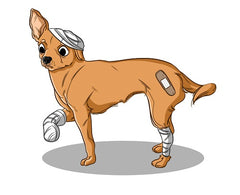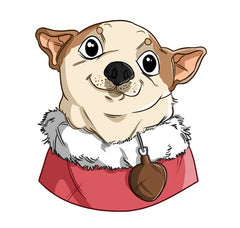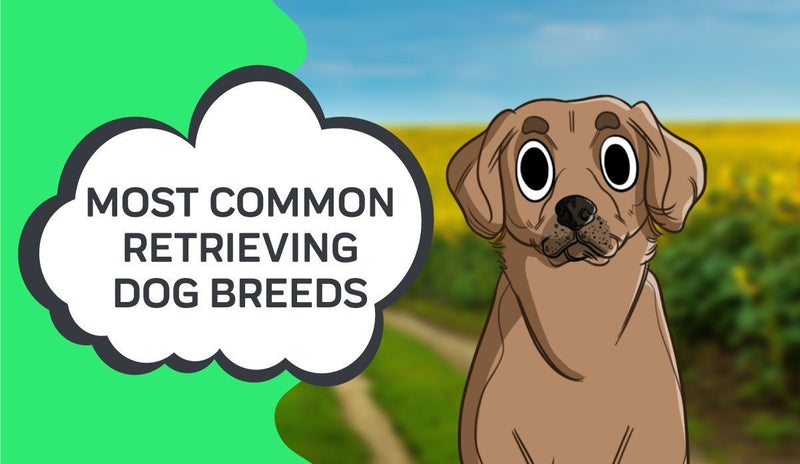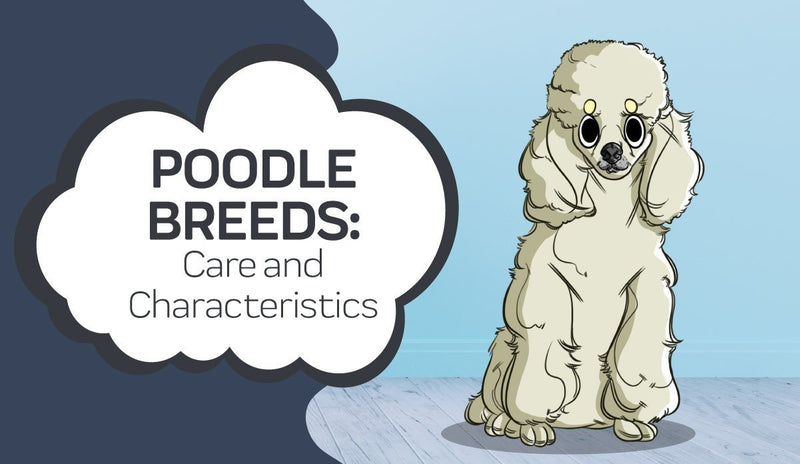 Chihuahua’s are among the most misunderstood and dynamic canine breeds in existence. They are kind of the ‘love em’ or hate em’’ pup that are loved by many, and annoyances to others. The smallest pup of all 155 AKC breeds—never weighing in beyond 7 pounds—their delicate bodies aren’t any obstacle for their confident and stubborn demeanors. These tiny dogs think the world of themselves, and oftentimes lack the capability of discerning their own size from that of additional (always bigger) dogs.
Chihuahua’s are among the most misunderstood and dynamic canine breeds in existence. They are kind of the ‘love em’ or hate em’’ pup that are loved by many, and annoyances to others. The smallest pup of all 155 AKC breeds—never weighing in beyond 7 pounds—their delicate bodies aren’t any obstacle for their confident and stubborn demeanors. These tiny dogs think the world of themselves, and oftentimes lack the capability of discerning their own size from that of additional (always bigger) dogs.
Oftentimes a one-person canine, the Chihuahua’s one goal in life is to love, as well as be loved unconditionally. They are full of enthusiasm and will adapt to almost any living situation, though they dislike extremes. They are a wonderful dog breed and if correctly socialized and trained, there isn’t any reason why they ought to be aggressive or aloof towards strangers.
All in all, Chihuahuas generally are a healthy breed, and have the ability to outlive the majority of dogs. Despite their physicality, they’re resilient as it’ll come to sickness. Enough so that a few live to be 20 years of age, which few dog breeds have the stamina for.
It’s highly unlikely that your pet will suffer any of the following health conditions listed below, yet, it is important for you as the pet owner to be aware of what is more than likely to happen if your Chihuahua mix is to fall sick.
Common Chihuahua Health Problems
Injury
While this is not a specific condition, it is first on our old chihuahua health problems list because it is the top cause of chihuahua health problems—but especially Chihuahuas. They like to follow their pet parents around. They just want to be included in all things you do and oftentimes act as a ‘shadow’, despite what their pet parent is doing. And as accidents occur (if they fall off the sofa, etc.) they are such delicate animals that injury oftentimes follows.
Apart from their snappy and jealous behavior, the other reason why Chihuahuas never should be around small kids is because the youngsters oftentimes lack the awareness in handling the Chihuahua.
Kids will ‘rough play,’ which results in a Chihuahua that has a severe injury. Their bone structure is lithe and thin (but more on that later), and susceptible to breaking. Therefore, it’s something to pay close attention to.
Let’s go into more detail about weak bones in canines.

With the number of activities that canines engage in over the day’s span, it is vital that they have healthy, strong bones for support! The canine’s skeletal system is a very critical mechanism for all things jumping, running, catching, and digging, and it’s imperative to improve and monitor the condition of your pup’s bones – particularly with age.
But there are numerous abnormalities and diseases that may happen during your furry companion’s lifetime that drastically can impact his skeletal structure and bones. Being aware of the types and symptoms of conditions that your pup might have concerning weak bones will assist with more severe problems in the future if recognized in earlier stages.
Fractures: As senior dogs have weaker bones and are thereby more predictable bone injury victims, those accidents are also typical among younger dogs. In instances of bone disease, fractures will be frequent and often will be indicated through x-ray scans. Those images are analyzed by your vet or experienced specialist, who’ll have the ability to make treatment suggestions.
Closed Fractures: As a canine’s bone is cracked yet his overlying skin stays intact, the area likely will inflame. Casts will aid with the process of healing the bone, of which recovery time will range from 5 weeks for younger pups to 12 weeks and up for older ones. More severe fractures might need more serious treatment to make sure of correct realignment.
Greenstick Fractures: Because a bone is intact, yet cracked in multiple areas, greenstick fractures are categorized as “incomplete fractures.” That might make it challenging for your pet to walk because of slight inflammation of the affected space. In this instance, it’s smart to consult a vet to make sure that the fracture heals properly, which is going to mitigate the probability of long-term problems which arise with incorrectly healed bones. Not doing so might result in lameness or decreased joint mobility.
Compound Fractures: Due to the bone being exposed, it’s very vulnerable to infection from contamination with dirt or debris. Screws and steel plates or surgical treatment are oftentimes used to treat such fractures; however, your vet ultimately should make the end call concerning treatment course.
Epiphyseal Fractures: Such fractures happen as the canine’s growth plates, which are spongy and soft in younger pups, are fractured. Because Chihuahua’s bones are still growing, those non-calcified space are more susceptible to damages than the remainder of the bone.
Those soft spaces are discovered at the ends of the humerus and femur, or any long bones which are in their developmental stages. Such fractures will probably heal quicker due to the realization that they usually happen in younger dogs that have stronger immune systems, yet it’s a great idea to check in with the vet to ensure that the bones properly heal when they do.
Osteoporosis: Osteoporosis is a bone disease affecting many human beings, yet it also can be discovered in dogs. As canines are diagnosed with this disease, bone density significantly decreases. It’ll lead to chronic pain in several body areas, debilitation, and very high vulnerability to fractures –telltale indications that yield a visit to the veterinarian.
Panosteitis: This is an additional bone disease which may be discovered in dogs who suffer leg pain. Panosteitis is more commonly discovered in large breeds like Labrador Retrievers, German Shepherds, and Great Danes. While it typically presents itself when the dog is six to eighteen months of age, it sometimes can happen in middle-aged ones, too.
Typically, the disease lasts 2 - 5 months – however, may last longer in more severe instances. Panosteitis is most easily identified when lameness or pain shifts from one leg to another because of bone proliferation or increase in bone density, creating misshapen bone structures or roughness.
Typical symptoms of dogs that have panosteitis include elevated fevers, high white blood cell counts, reluctance to exercise or walk, and occasionally, related tonsillitis. Abrupt leg lameness also is a sign of this disease. The panosteitis’ causes are presumed to come from several different factors which are completely situational.
HOD (Hypertrophic Osteodystrophy): HOD, or Hypertrophic osteodystrophy, affects many of the same pups that also are impacted by panosteitis. Also called osteodystrophy type II, Moller-Barlow disease, or skeletal scurvy, HOD usually presents itself through ongoing leg pain or lameness. But, HOD is different from panosteitis in that it’ll affect several legs simultaneously and oftentimes comes with more serious debilitation and pain, making it hard for the dog to move or walk.
Patellar Luxation
The patella comprises of three parts (calf, kneecap, and thigh bone). Luxation is a fancy term for dislocation. As you may deduce, patellar luxation happens as the kneecap continually shifts in and out of place. Its symptoms may be an abnormal gait, various pain degrees, leg lameness, and the worse immobility.
Because of the realization that the condition fluctuates in its severity, there are several different kinds of chihuahua health issues treatment available. From physical therapy to corrective surgery.
Dental Problems
This breed of dog has weak teeth. Some are actually born with very little enamel, which means they are susceptible to rot and cavities. A fast Google search of chihuahua illness will show just how notorious these breeds are for having bad breath. It’s actually partially due to their dental hygiene, as the dog’s teeth are fickle and oftentimes malnourished.
Usually, bad breath is the most obvious symptom; however, an inspection also can expose plaque and tartar build-ups, premature tooth loss, and sometimes cavities. It is vital that you spend a good amount of time on your dog’s teeth, as they’ll come predisposed to having bad dental hygiene. Consider using natural dental products for dogs, and if your dog doesn't do well with dental cleanings, try checking out our 100% natural no brush, pet oral care gel for dogs to fight plaque, tartar, and bad breath!
Hypoglycemia
One intriguing thing about this breed of dog is while they certainly are the dog that lives the longest, they also can be especially unhealthy. Hypoglycemia—additionally referred to as low blood sugar—is a situation found in the majority of toy breeds. Their tiny bodies have a more difficult time regulating their blood sugar; however, if it is caught early, there virtually isn’t any risk and it is easily treatable.
Symptoms involve a loss of appetite, extreme fatigue, shivering, and hair loss. At worse, if hypoglycemia is misdiagnosed or is left untreated, the animal may slip into a coma from organ failure.
That is why it is imperative that if your pet is suffering any of the above symptoms, to take him to a vet to assure there is not something severe happening.
Shivering
This breed is known to shiver. While generally this is not a chihuahuas health issues factor, it’s on our list because it almost is always addressed by pet parents. Shivering may be a sign of a more serious problem because of the hypoglycemia mentioned above, yet typically it is due to the realization that they do not have a lot fat under their coats.
Additionally, smaller pups usually have a hyperactive metabolism, which means they constantly are shedding body heat. Tiny canines across the board shiver, yet this breed does it particularly often. It usually isn’t something to be concerned with; however, if it seems abnormal, do not hesitate to take your pup for a check-up.
Heart Murmur
Oddly enough Chihuahuas usually have heart murmurs. They are generally benign, and there isn’t any cause for concern, yet during other times they may raise a red flag for heart disease. If the vet determines that there is a reason to assess further, then they will take X-rays and do an EKG. If there’s in fact something wrong, oftentimes the Chihuahua must adjust his amount of exercise, lifestyle, and diet.
Hip Dysplasia
Maybe the most common condition afflicting the dog species, chihuahua hip dysplasia happens as there is displacement between the hip joint and thighbone. Hip dysplasia symptoms may include lameness in the leg(s), difficulty walking, an abnormal gait, and pain. Like patellar luxation, the levels of severity range from the dog requiring zero treatment, all the way down to corrective surgery.
Typically, this chihuahua hip problems condition affects larger dogs which grow too rapidly into their bodies; however, Chihuahua’s have such fragile and frail frames that oftentimes their hip dysplasia’s origin stems from an injury they suffered in their youth. However, as aforementioned, there are an abundance of “chiwawa” health issues treatments available, and they almost are always successful.
Pulmonic Stenosis
It’s a congenital heart disease that happens as blood does not correctly flow through the dog’s heart. The reason it is referred to as ‘pulmonic’ is because that is the valve which does not properly form and causes the heart to work two times as hard to pump blood all throughout the body.
The pulmonic stenosis’ severity greatly differs from one case to another, with some requiring no more than dietary changes, and other ones needing heart surgery. The condition may be deadly if undiagnosed, as ultimately the heart will wane then fail under the stress.
Collapsed Trachea
There are different methods in which the trachea may collapse, yet oftentimes it is attributed to a hereditary disorder which weakens the tracheal ring lining and causes them to flatten over a period of time.
As it continues, the airways thin, and it’ll become more and more difficult for the dog to take in oxygen. If serious enough, it certainly can be severe, as the lack of oxygen starts to affect other organs. There are preventative steps and surgery out there for a collapsed trachea.
Hydrocephalus
In addition to chihuahua cancer, hydrocephalus generally affects puppies within their first two to six months, and is usually fatal. Hydrocephalus happens as cerebrospinal fluid clumps inside the brain because of trauma or obstruction during birth, pushing the brain against the skull. The dog’s head will rapidly swell, and within an attempt to save the puppy vets sometimes will use a shunt to displace the fluid from the dog’s brain to his abdomen.
They also will periodically use steroids to aid in reducing the pressure. However, puppies that have severe cases of hydrocephalus will pass away before reaching five months. Some folks suggest waiting on making a purchase of a Chihuahua until they are that age, even though this condition is extremely rare.
PRA (Progressive Retinal Atrophy)
PRA directly affects a dog’s eyes, and it happens as the photoreceptors at the back of an eye start failing. Symptoms initially start with night blindness—the dog will have a very hard time seeing in the dark. However, as it progresses, it ultimately starts affecting their daytime vision, too.
Unfortunately, there isn’t any cure for this condition and as it develops, it’ll lead to 100% blindness. But vets may diagnose it early on and permit the correct time for both dog and owner to get ready for blindness. Except for a loss of vision, Progressive Retinal Atrophy does not have any additional physical effects on the body of a Chihuahua.
How to Keep Your Chihuahua Healthy
The above are conditions that may impact a Chihuahua, yet rarely will do so. Now that you are armed with that knowledge, it is vital to take the necessary measures in ensuring that your dog will lead the healthiest possible life. Here, we list a few tips.
Purchase the Proper Food
Do not be cheap about your dog’s diet. These little dogs have fast-working metabolisms and require the best quality dog food available. Not just that, yet Chihuahua’s may be fickle about their food options. Work with your vet to make sure you are providing your dog the right diet.
Take Your Dog to The Vet
It is amazing how few pet parents actually take their pet to the vet for yearly checkups. Even if your pup is healthy, there is a ton of value in keeping records of his aging process (height, weight, etc.).
Most of the conditions mentioned above must be treated in their earliest phases, meaning they must be caught early. That is what the pros are for.
Groom the Chihuahua
Chihuahua’s have pretty much the most manageable coat of all breeds. Be certain to groom and examine your pet weekly and look for anything abnormal. Be sure to also brush your dog's teeth two to three times per week, because Chihuahuas—of all dogs—require it. On a monthly basis, trim your dog’s nails, as they will not wear them down on their own.
Finally, Exercise
Chihuahua’s tend to become lethargic as they age. They will locate their spot on the sofa and determine that is their habitat for the remainder of life. However, despite their tiny size—like every other animal—they also need exercise. Keep in mind, a stroll around the block for you is a difficult work out for them. Make certain that you motivate your pet to remain active as his energy starts waning and balance his level of activity with his food consumption.
For more information contact Innovet Pet Products today!
Sources:
Chihuahua Health ProblemsChihuahua
Tracheal Collapse
Cannabidiol attenuates high glucose

Thanks for stopping by!
P.S. We Love You!
Sincerely,
The Innovet Team
Please do not ask for emergency or specific medical questions about your pets in the comments. Innovet Pet Products is unable to provide you with specific medical advice or counseling. A detailed physical exam, patient history, and an established veterinarian are required to provide specific medical advice. If you are worried that your pet requires emergency attention or if you have specific medical questions related to your pet’s current or chronic health conditions, please contact or visit your local/preferred veterinarian, an animal-specific poison control hotline, or your local emergency veterinary care center.
Please share your experiences and stories, your opinions and feedback about this blog, or what you've learned that you'd like to share with others.

















